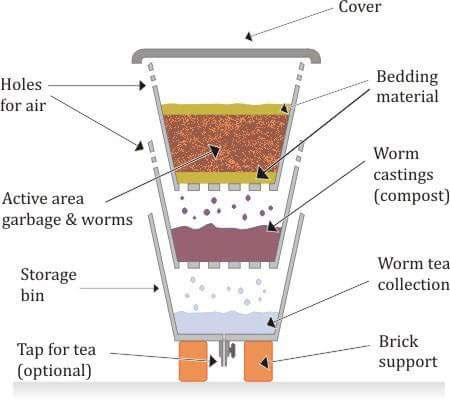Farmers can now improve their kitchen garden yields at low cost by setting a simple vermiculture system separating the worms, vermicompost, and vermiliquid which are very essential to plants growth.
According to George Muturi, founder of Agri-Tech Organic Farm startup, experts in organic chemicals and redworms, farmers incorporating vermiculture in crop production enables them provide comprehensive minerals to the plants than those relying on synthetic fertilisers.
“Both vermicompost and vermiliquid supply crops with both micro and macro nutrients, which are necessary for holistic growth,” Said Muturi.
In this, the startup has come up with a three-in-one vermiculture system that separates the worms, vermicompost and vermiliquid in different chambers making it easy to use and maintain and ideal for anyone living in apartments and looking for a sustainable way to dispose of any organic waste.
RELATED ARTICLE: Farmer earns from rearing red worms for organic manure

Setting up the system
Only three buckets of twenty litres capacity with wider top and narrow bottom, rabbit manure and five kilos of starter-worms worth Sh2,500 is a good point to start from.
The buckets are inserted into each other in such a way that they do not touch each other at the bottom.
The topmost bucket in which the worms, rabbit manure and fresh organic wastes such as fruit and vegetable remains are placed is covered at the top and some holes made on the upper sides for letting in fresh air.
The worms, rabbit manure and fresh organic wastes are sandwiched with some dry matter materials such as grass on top and bottom. Some holes of considerable sizes are is also made at the bottom of this top bucket to allow vermicompost and vermiliquid pass through to the second bucket.
“Rabbit manure is preferable to any type of manure because it speeds up the worms’ reproduction leading to faster decomposition of the wastes for more compost manure and vermiculture liquid,” said Muturi.
RELATED ARTICLE: Worms\’ liquid offers crops more nutrients than fertilisers
The middle or second bucket is where the vermicompost is collected depending on the activity of the worms on the organic wastes and the manure. The bucket too has some smaller holes than the upper one allows vermiliquid from the worms in the top bucket to pass through to the lats or bottom bucket.
The last bucket which is raised some few inches from the ground using some bricks, stones or wood has a tap at the bottom through which vermiliquid is tapped.
Vermicompost accumulated in the second bucket is used as manure for crops while vermiliquid collected in the bottom bucket acts as organic foliar and it is best for crops such as fruits and vegetables as started in the introduction.
RELATED ARTICLE: Farmer ventures into earthworms farming to fix tired soil
besides using them for their own crop production, the compost and the liquid can be sold to other farmers for income.
Agri-Tech Organic Farm sets, for interested farmers, the smaller vermicompost system made from 20-litre capacity buckets at Sh4,500 each and larger vermicompost system made from 50-litre capacity bin at Sh6,000.
Muturi or Agri-Tech Organic Farm can be reached on 0717411668/ 0727675682